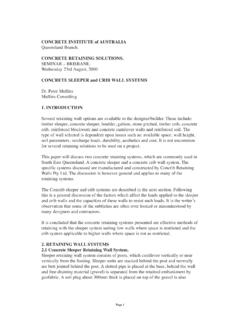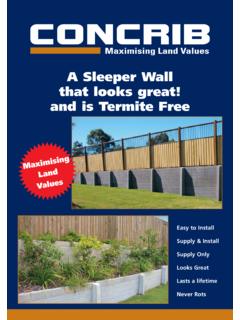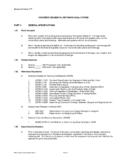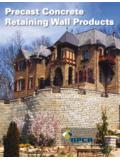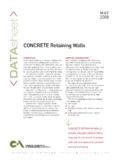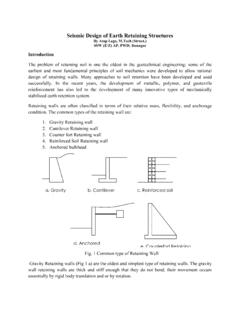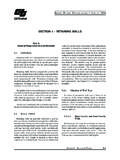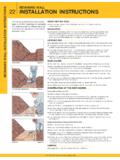Transcription of How to choose the right retaining wall for your …
1 1 There is much to consider when choosing the right retaining wall for your application. We have drawn on years of experience in the earth stabilisation business and put together a short checklist of seven fundamental choice document is by no means definitive, but it aims to equip you with sufficient information to guide you through the initial phase of the decision making process. The seven fundamental choice parameters:1. The type of retaining wall retaining walls can be broadly divided into four main categories namely, gravity walls , cantilever walls , anchored walls , and reinforced soil or nailed walls . Each type of retaining wall has its own particular characteristics, which make it more suitable for certain applications than others. Here is a brief overview of the four categories of retaining walls : a. Gravity walls These are arguably the oldest and most frequently used retaining walls .
2 They are often made from stone or other heavy materials, and rely on the weight of their own mass to resist pressures from the retained material. Gravity walls should be a minimum of 50 to 60% as thick as the height of the wall. They may have to be larger if there is a slope or surcharge on the wall. Modern gravity walls include concrete crib walls , gabions, boulders, and large, precast concrete blocks. Gabions are a type of soil strengthening, consisting of wire mesh cages into which roughly cut stone or other material is filled. Gabions work to reduce internal movement and erosive forces. b. Cantilever walls Before the introduction of modern reinforced-soil gravity walls , cantilevered walls were the most common type of taller retaining wall. This type of wall uses much less material than a traditional gravity wall. Cantilevered walls are made from a relatively thin stem of steel-reinforced, cast-in-place concrete or mortared masonry, fixed at one end, usually by way of a simple, embedment or cantilever foundation (often in the shape of an inverted T).
3 These rigid concrete footings must be positioned into firm suitable foundations. The wall operates like a beam cantilevering the load to a large, fixed structural base converting horizontal pressures from behind the wall into vertical pressures onto the ground below. Sometimes cantilevered walls are buttressed on the front, or include a counterfeit on the back, to improve their stability against heavy loads. How to choose the right retaining wall for your project12 Buttresses are short wing-like walls at right angles to the main trend of the wall. Typical cantilever walls include reinforced concrete, or concrete-filled blockwork, concrete or timber sleeper walls , concrete, steel or timber sheet pile, or contiguous piling. c. Anchored walls These walls are pinned both top and bottom using cables, or other stays, which are anchored in the rock or soil behind it. Anchors are driven into the material and then expanded at the end of the cable, either by mechanical means or by injecting pressurised concrete into the hole.
4 They concrete expands to form a bulb in the soil. The wall may be embedded at the base and tied to a slab at the top or to a deadman anchor a concrete structure which is driven into the ground or anchored to the earth with sufficient resistance. The horizontal cable, rod or helical anchor, and deadman structure resists forces that would otherwise cause the wall to become unstable. This method, though technically complex, is useful where high loads are expected, or where the wall itself has to be slender and would be too weak without anchoring. d. Reinforced soil or nailed walls These systems do not simply consist of the wall itself, but make use of reinforcing grids or straps to contain and stabilise the slope. The traction-resistant reinforcement elements change the nature of the soil mass and reduce the earth pressure acting on the wall. In mechanically stabilised earth (MSE) walls the soil is artificially reinforced with layered horizontal mats (geosynthetics).
5 These mats provide additional internal shear resistance beyond that of simple gravity retaining structures. Layered steel straps may also be used. Reinforcing layers are attached to outer facing walls (typically segmental retaining walls ). The wall face is usually made of precast concrete units that can tolerate some differential movement. When the reinforced soil mass is sufficiently large to retain the pressure from the soil behind it, it works with the wall to provide stability. Nailed walls make use of slender elements normally steel reinforcing bars which are inserted into pre-drilled hole and grouted into place. The reinforcing bars are usually installed untensioned at a slight downward angle. Isolated soil nail heads or a rigid (or flexible) facing (often of sprayed concrete) may be used on the surface of the wall. Typical reinforced soil or nailed walls include concrete or steel panel-faced walls , segmental walls , wire mesh or fabric-faced walls and shotcrete-faced nailed The material to be retained Important questions to ask upfront include: Will the wall be retaining a cut face or fill material?
6 If it is fill material, will it be controlled fill? If it is a cut face, what type of ground is it? Generally, building a wall to retain fill material allows for a wider choice of wells than a wall designed to retain cut Cut faces are often positioned on the boundary of properties, which places a limit on the footprint of the wall system. Any of the wall types requiring reinforcement will not be suitable in such cases, as the reinforcing elements (grids or straps) will encroach over the boundary. Reinforced walls also frequently have to be bulked out and then re-compacted or bulked out and replaced with a suitable fill material. This is often impractical for cut face applications even when the face is not on a boundary. Boulders may be used for retaining cut faces, but these structures require skilled operators and rigorous monitoring during the construction process. Crib walls are excellent for cut face applications as they are well-understood repeatable-engineered structures.
7 Reinforced walls are ideal for retaining fill material as there is no unnecessary bulking out of material and the reinforcing elements are encapsulated in the The footprint of the wall Crib walls can be built to great height in excess of 10 metres, but being a gravity system, the higher the wall, the thicker the base (footprint) must be. This makes them unsuitable for applications where vertical height is required and space is limited. Concrete sleeper walls can be used in either cut face, or fill applications. As they are vertical cantilever systems, they typically have a narrow footprint (usually around 500mm). This makes them ideal for use on small lot housing developments where the land use of blocks can be effectively maximised. Sleeper walls are used up to heights of 3m with a vertical face. The table shows typical Wall heights and corresponding footprints for boulder walls , concrete crib walls and concrete sleeper walls .
8 Wall height and footprint comparisonWall height/mmBoulder wallsConcrete crib wallsConcrete sleeper wallsBaseSetbackFootprintBaseSlopeSetbac kFootprintBaseSetbackFootprint1000800550 1350500250200950280200480150011006501750 7003752001275310200310200014007752175100 0500200170035020055025001750900265010006 2520018253802005803000215010253175100075 0200195040020060044. The constructability of the wall system This includes considerations such as: The wall environment (for example whether it is adjacent to water, the soil chemistry, salinity, etc) Accessibility of the area where the wall is to be built The size of the footprint available for the wall The required height and length of the wall The slope of the ground above the wall The slope of the ground at the bottom of the wall Any surcharge loads applied above the wall (including live loads such as those applied by roads, or dead loads such as those applied by buildings)
9 The availability of solid ground for a foundation Any services, trenches or pipelines near the base of the Adherence to retaining structures code and other legislation The structure must comply with the AS4678, retaining Structures Code, and any manufactured/fabricated products must also comply with their respective codes (for example, structural concrete must fulfil the requirements stipulated in AS3600).6. Design life, durability and long term maintenance The structure must be durable and meet the design life requirements stipulated in the relevant construction codes. Long-term maintenance requirements must be taken into consideration and factored into the Aesthetics This has become an increasingly important consideration in the selection, design and construction of retaining walls . Modern walls can be planted out and/or coloured with long-lasting coloured sealants to enhance the aesthetic aspect.
10 Concrete sleeper walls have the advantage over timber walls as they can be constructed with a wood grain finish, coloured with sealers, and they do not rot. While these seven fundamental choice parameters serve as a useful guide when choosing a retaining wall, it pays to bear in mind that every project is unique. When finding the right solution to meet the specific challenges of your project, it pays to consult the professionals. At Concrib, we have more than 25 years of experience in the design, manufacture and construction of retaining walls and earth stabilisation structures. Call us on (07) 3375 1800, our team of industry-qualified technical consultants will gladly discuss your requirements and advise you on the best solution for your
